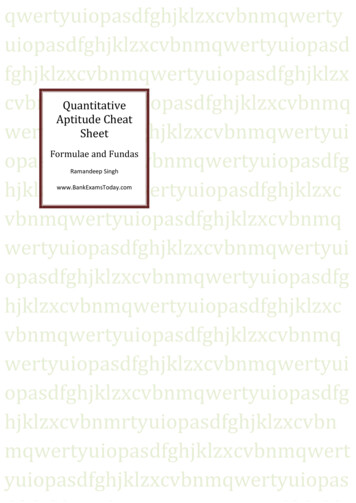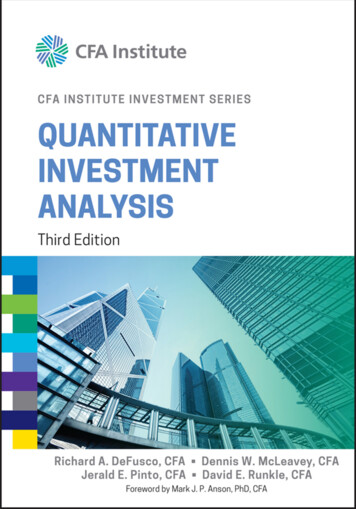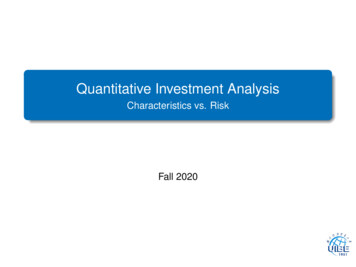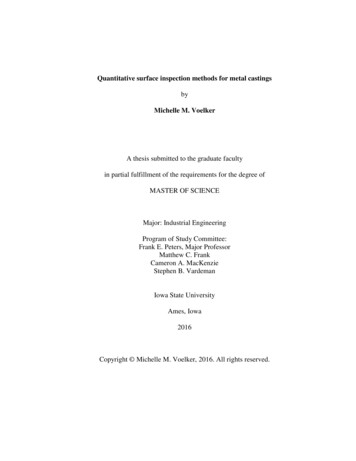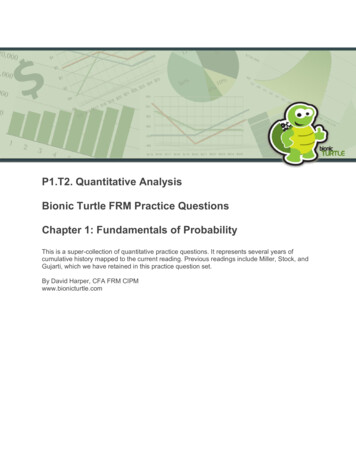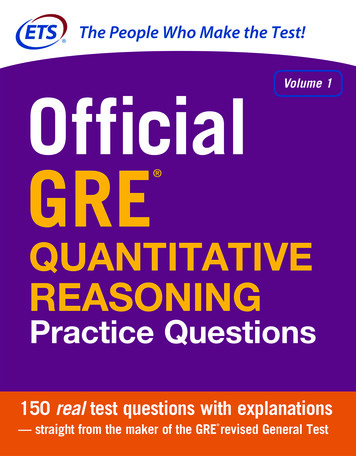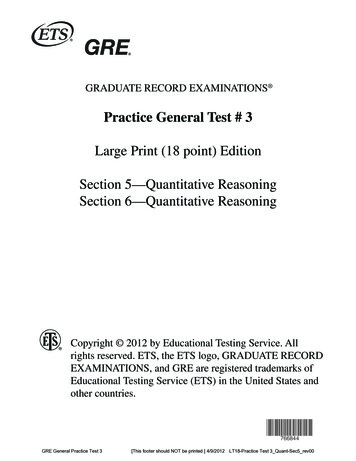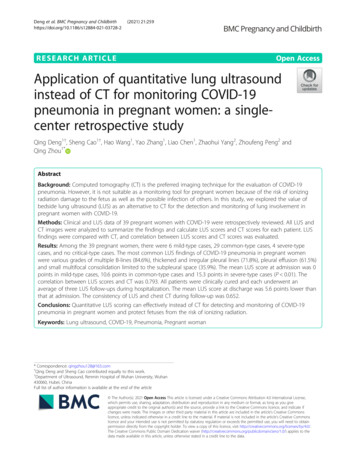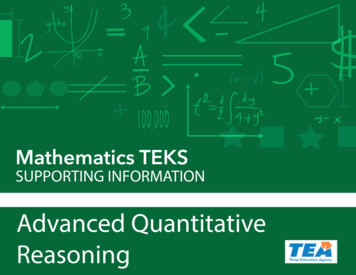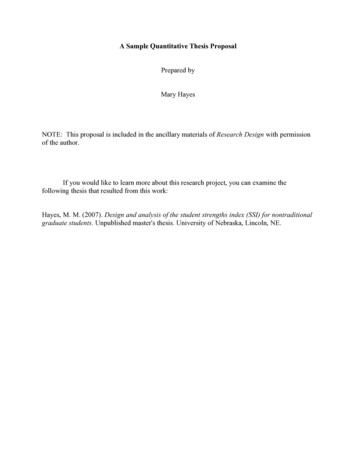
Transcription
A Sample Quantitative Thesis ProposalPrepared byMary HayesNOTE: This proposal is included in the ancillary materials of Research Design with permissionof the author.If you would like to learn more about this research project, you can examine thefollowing thesis that resulted from this work:Hayes, M. M. (2007). Design and analysis of the student strengths index (SSI) for nontraditionalgraduate students. Unpublished master's thesis. University of Nebraska, Lincoln, NE.
Design and Analysis 1Running Head: DESIGN AND ANALYSIS OF THE STUDENT STRENGTHS INDEX(SSI)FOR NONTRADITIONAL GRADUATE STUDENTSDESIGN AND ANALYSIS OF THE STUDENT STRENGTHS INDEX (SSI)FOR NONTRADITIONAL GRADUATE STUDENTSMary HayesUniversity of Nebraska LincolnApril 28th, 20071
Design and Analysis 2I. IntroductionBackground of the studyIntroductionAdmission committees at graduate schools across the United States are chargedwith the task of deciding who to admit into graduate programs. These decisions are oftenbased on readily available measures used to predict the likelihood of student successincluding standardized examinations such as the Graduate Records Examination (GRE)and measures of past performance such as the Undergraduate Grade-Point Average(UGPA). Sternberg and Williams (1997) examined the uses of the GRE to admit studentsto graduate school. Some schools use the GRE score as a cut score to even be consideredfor admission or provide an average GRE in their admission materials (p. 631). While theuse of these measures is common practice, it is not clear whether these measures canaccurately predict student success in all graduate student applicants. When consideringpopulations of graduate students described as nontraditional, often over 30 years of age orseveral years removed from their baccalaureate degree, these measures take on increasedimportance (Hartle, Braratz, & Clark, 1983). This study examined the use of a noncognitive assessment tool to measure student’s strengths which can be used as anadditional factor for admission committees when considering admitting nontraditionalgraduate students.Statement of ProblemThe current admission criteria vary from university to university. Schools oftenrequire a student to take a standardized exam such as the Graduate Records Examination(GRE) which can be weighted heavily in the overall admission decision (Kuncel, Hezlett2
Design and Analysis 3& Ones, 2001). Standardized examinations are typically designed for traditional-agedstudents, who tend to perform better than nontraditional aged test-takers. Lindle andRinehart (1998) state “the GRE was designed for ‘traditional’ graduate students, thosewho pursue advanced studies full time immediately or shortly after attaining theirbaccalaureates” (p.1). Other studies have found that older students score significantlylower particularly on quantitative measures associated with the GRE (Clark, 1984;Hartle, Braratz, & Clark, 1983). If admission or selection decisions are based primarilyon measures such as the GRE alone, the potential impact of adverse decisions isenormous because an estimated 48.6% of the 2,637,000 students entering graduate schoolin 2003 were over the age of 30 (Digest of Educational Statistics, 2004). Most schoolsuse multiple factors to consider applicants for admission. However, schools have alimited amount of resources to admit students each year. There are more applicants thanpositions to be filed. The number of applicants to admitted students varies by departmentor school; at Yale University in the Comparative Literature department reports a 10:1ratio for applicants to acceptance ovember 15, 2007)). There is no explicit minimum stated; however, they make notethat “the scores of those admitted tend to be high to very high.” The ratio for applicants toadmission for the Department of Planning Policy and design at University of CaliforniaIrvine for the PhD program is 5:1 (http://socialecology.uci.edu/?q ppd/faq, (November15, 2007)). The minimum GRE combined for UC-Irvine is 1000; the website states that“applicants falling below the minimum on either standard should exhibit compensatorystrengths in other areas.” At the University of Nebraska-Lincoln in the EducationalPsychology department the admit ratio varies by specialization, 2:1 for Cognition,Learning and Development (CLD); 1.5:1 for Quantitative Qualitative and Psychometric3
Design and Analysis 4Methods (QQPM); 5:1 for Counseling Psychology, and 4:1 for School Psychology. (E.E.Burgess, Admission Administrator, personal communication, November 20, 2007). Thereis no minimum for the department of Educational Psychology stated publicly. As thenumber of applications increases the more selective the universities and colleges tend tobe in terms of cut scores for the GRE.Schools also require the applicants to provide other information such as letters ofrecommendation and a personal statement of goals. The letters of recommendationsreceive high importance ratings to many graduate programs in psychology (Fauber,2006). Applicants tend to choose individuals that they know will provide stellarrecommendations. Therefore, these measures are subjective in nature and may notprovide an accurate picture of the student’s success characteristics in graduate school.Significance of studyEducation is an important investment in one’s future. For the past two decades theinflux on nontraditional students into post secondary education has a dramaticallyincreased. These students are older and have many responsibilities outside of theireducation. They take classes online, on weekends and evenings. They are aware of thebenefit that an education can give to them. They sacrifice a great deal in order to get theeducation they know they need. They understand that in order to succeed in their chosenprofession they need further education (Beitler, 1997). This is one of the reasons thatolder students return to school after a long absence. One of the major obstacles fornontraditional students is the GRE which can be biased against these students (Murray,1998). These students are often denied admission into graduate school based on scoresthat may not be a true reflection of their ability to succeed in graduate school.4
Design and Analysis 5Need for StudyResearch exploring the use of measures such as standardized examinations andthe UGPA to predict performance in graduate school is plentiful (Holt, Bleckmann &Zitzmann 2006, Nelson & Nelson, 1995, Sacks, 1997, Sacks, 2003). Sacks (2003) statedthat the use of standardized tests “blinds us to what’s real about individual students andtheir real-world skills, academic or otherwise” (p. 20). Unfortunately, despite the oftenreported shortcomings of these measures, there is relatively less research exploringalternative selection practices for the nontraditional graduate program applicant. Thenontraditional student tends to be “achievement oriented, highly motivated, and relativelyindependent” (Cross, 1980). Others describe them as “meta-motivated” and “goaloriented” (Davis & Henry, 1997). Davis and Henry (1997) state nontraditional students“have special needs and capacities that distinguish them from traditional students” (p. 3).Failure to consider factors such as motivation and goal orientation could lead to theexclusion of many potential nontraditional graduate students who could have beensuccessful. This is an area where the current research falls short. There is currently noassessment available that students can take to demonstrate objectively to graduateadmissions committees the extent of motivation, interaction, cognition and execution theypossess. If these could be measured, admission into graduate school could be based onmultiple factors above and beyond the traditional cognitive methods alone.The purpose of the study was to design and validate a tool called the StudentStrengths Index (SSI) to assess motivation, interaction, execution and cognition andcreate a success profile of the nontraditional graduate student. Specifically, this studyaddressed the following research questions:5
Design and Analysis 61. Can a non-cognitive instrument to measure motivation and other competenciesbe developed to predict success of the nontraditional student in graduate school incomparison to the traditional means?2. Does the motivation, interaction, execution and cognition of nontraditionalstudents predict success in graduate school?Assessments such as the SSI are used everyday in the business arena to helppredict success of individuals in sales, management and other professional careers. TheSSI was adapted from a tool originally created by TalentMine LLC called theTalentMine1 Index (TMI). This tool is used to design strengths profiles to selectindividuals who will succeed in the position they are applying. If a profile could bedeveloped of a “successful nontraditional graduate student” then this information couldbe used in conjunction with the GRE and other measures as a selection tool for admissioncommittees to select individuals who will succeed in graduate education.HypothesesThe following are the primary hypotheses of this project.1. Nontraditional students’ motivation, interaction, execution and cognition arecontributing factors in their success in graduate school.2. There are no differences in non-traditional students’ motivation, interaction,execution and cognition based on gender or degree.3. The Student Strengths Index (SSI) and GRE composite score are significantpredictors of success in graduate school.1TalentMine Index is the intellectual property of TalentMine LLC, therefore the instrument is not included.6
Design and Analysis 7LimitationsThe sample consisted of University of Nebraska Lincoln (UNL) graduatestudents. UNL is a public university located in the Midwest and the enrollment isapproximately 22,000 undergraduates and 4,500 graduate students. Study participantswere selected based on the criteria that they had completed at least nine hours of graduatecourse work at the university.The sample did not include other regions of the country, private colleges anduniversities or small colleges and universities.The SSI instrument was designed using items from the TalentMine Index (TMI)which was initially design for finding strengths in the professional community. This TMIwas not originally designed to measure nontraditional graduate school success.The success outcome measure of Graduate Grade-Point Average (GGPA) is notconsistent for all students in the sample. Individuals selected to participate in the samplehad at least nine hours of graduate coursework but no maximum hours of course workwas stated.Definition of TermsCognition. Cognition is the ability to use common sense and creativity to solvecomplex situations using different analytical methods.Execution. Execution is the ability to complete one’s education despite having toovercome obstacles.Graduate Success. Graduate success is measured in this study by the Graduategrade point average.7
Design and Analysis 8Interaction. Interaction is the ability to work collaboratively with others as amember of a team, the ability to communicate effectively and relate to others in aprofessional manner.Motivation. Motivation is the ability to pursue a goal for personal achievement.The persistence to complete what one has started.Nontraditional Student. The nontraditional graduate student is an individual whohas been removed from formal education for at least five years. Nontraditional studentsalso are individuals who are older than their traditional counterparts.Nontraditional graduate students bring a set of strengths that is in addition to whatcan be measured by a standardized cognitive test. These students are motivated to pursuethe education that is necessary to get the promotion or the new position because theyknow that it is required. The aim of this study was to design an instrument to measurethese strengths to be used in conjunction with the traditional measures.Literature ReviewGraduate school admissions committees across the United States are faced withthe task of deciding who to admit into graduate school based on specific factors thatpredict success. These factors include the traditional cognitive measures of the GraduateRecords Examination (GRE) and the Undergraduate Grade-Point Average (UGPA).Sternberg and Williams (1997) examined the uses of the GRE to admit students tograduate school. Some schools use the GRE score as a cut score before applicants areeven considered for admission (p. 631). Sternberg and Williams (1997) discussed anunnamed school that separates the applications upon arrival by GRE score; “GRE Below1200, 1200 to 1300, 1310 to 1400 and Above 1400” (p. 631). The first two categories arerarely admitted or even reviewed, the last two are where the majority of students for the8
Design and Analysis 9program are admitted, but primarily from the “Above 1400” group. The GRE and UGPAare two of the criteria that admissions committees use to evaluate students for admissioninto their programs. Lindle and Rinehart (1998) stated that “the GRE was designed for“traditional” graduate students, those who pursue advanced studies full-time immediatelyor shortly after attaining their baccalaureates” (p. 1). These measures are biased andskewed to favor the traditional student. Nontraditional students are different fromtraditional students who have completed their baccalaureate degree and proceededdirectly to graduate school. Nontraditional students are motivated and driven to completetheir studies. This motivation is the key to their success. As seen in Enright and Gitomer(1989) “the differences between successful and unsuccessful (graduate) students aremotivational rather than cognitive” (p. 11). The study by Enright and Gitomer (1989)suggested that the reason many graduate students do not complete their education can beattributed to “the degree of commitment necessary to succeed” (p. 11).A review of the literature was conducted on the characteristics of nontraditionalstudents and what contributes to the prediction of their success in graduate school.Searches were conducted using PsycInfo and ERIC on GRE, UGPA, GGPA,Nontraditional Graduate Students, Adult Learners, and Motivation in graduate studentsand Predicting Success in Graduate Students.Nontraditional Graduate StudentThe nontraditional student has many names. Cross (1980) refers to these studentsas “adult students,” “re-entry students,” “returning students,” and “adult learners.” Thesestudents have been defined as being older students who have not followed the traditionalpath of the student from baccalaureate to graduate school (Bamber & Tett, 2000,9
Design and Analysis 10Hoffman, Posteraro & Presz, 1994). They usually continue to work while attendingschool and are strongly motivated to complete their education. Research by Hofmann,Posteraro and Presz (1994) suggests that the adult learner comprised 34% of theindividuals in post-secondary education or an estimated 6.6 million in 1992. Their studyincluded 40 recent graduates from three college programs and reviewed what factorscontributed to the success of nontraditional students. Two of the factors that weredetermined in the study were the need for access to resources and timely communication(p. 8). They stated that there are critical needs for this population and faculty should beaware of their needs as adult learners. Sudol and Hall (1991) echo this notion thatnontraditional students have special needs and characteristics. The study by Sudol andHall (1991) examined the personal, academic and professional advantages anddisadvantages from the perspective of 14 adult learners. One of the academicdisadvantages is the notion of completion in a timely manner. One of the participants inthe study called it the “hurry-up syndrome” (p. 6). “At this stage in life, older graduatestudents are less willing to dawdle or take detours” (p. 7). These individuals aremotivated to complete their education to be able to return to their lives. As the populationof nontraditional students grows it will be harder to ignore these individuals’ specialneeds and characteristics.The most recent version of the Digest of Educational Statistics (2004) estimatesthe number of students entering graduate school after the age of 30 is 48.6% of the2,637,000 individuals who started graduate school in 2003. The reasons for the influx arenumerous; women are returning to college after the raising of their children, manyindividuals are returning to advance their careers and on occasion begin a new career orto continue learning for learning sake (Benshoff & Lewis, 1993; Hofmann, Posteraro &10
Design and Analysis 11Presz, 1994, Sudol, 1991). The nontraditional student tends to be “achievement oriented,highly motivated, and relatively independent” as described by Cross (1980) and otherauthors describe them as “meta-motivated” and “goal oriented” (Davis & Henry, 1997).Davis and Henry (1997) state that nontraditional students “have special needs andcapacities that distinguish them from traditional students.” They are faced with manyobstacles that they must overcome to return to school. “Whether they are successful ornot in that quest depends in large part upon their desire and commitment” (p. 2). Thestudy by Davis and Henry (1997), focused on the forces that influence the nontraditionallearner in an educational setting. The sample consisted of two groups of nontraditionallearners, the first group attended classes on campus and the second attended classes viasatellite locations. They used the Goal Orientation Index (GOI), and the Myers-BriggsType Indicator (MTBI) in order to examine the nontraditional students “goal orientationstyle” and psychological type. They compared the differences of those nontraditionallearners who were participating in satellite education versus nontraditional students oncampus. There were significant differences in the GOI with respect to differentpsychological types. Differences existed between extrovert and introvert on all thecategories on the GOI. The nontraditional distance learners were highly goal oriented aswell as extroverted.In a study by Evans and Miller (1997), the characteristics of adult learners, basedon adult learner theory, were examined to see if there were differences in thecharacteristics across the ages of graduate students. Ninety students were surveyed usinga tool that was developed from the basic concepts surrounding adult learning. The studyfound that individuals motivation to learn changes as they age. Older individuals differedsignificantly on the need to consolidate what they have learned before learning new11
Design and Analysis 12concepts. The results depicted differences in Education Administration students whohave the “want it now” mentality as well as the desire to only receive or learn informationthat is pertinent to their needs (p. 13). This mentality could be attributed to futureprofessional position of the Education Administration students who upon graduationbecome principals or superintendents. This study illustrated the persistence to goal fornontraditional students.In a qualitative study by Sudol and Hall (1991), 14 nontraditional students,between the ages of 37 and 50, were interviewed about the process of succeeding ingraduate school. The findings suggested that these students have a sense of urgency. Oneparticipant stated that he knew exactly what he wanted and was going to do just that(Sudol & Hall, 1991, p. 6). With this type of motivation and drive the success ofnontraditional students could be tied to these attributes. To date no studies have beenconducted to understand the differences in motivation between nontraditional studentsand traditional ones. Motivation could be the key to the success of nontraditional studentsin graduate school.Success FactorsBeitler (1997) studied adults in self-directed gr
receive high importance ratings to many graduate programs in psychology (Fauber, 2006). Applicants tend to choose individuals that they know will provide stellar recommendations. Therefore, these measures are subjective in nature and may not provide an accurate picture of

